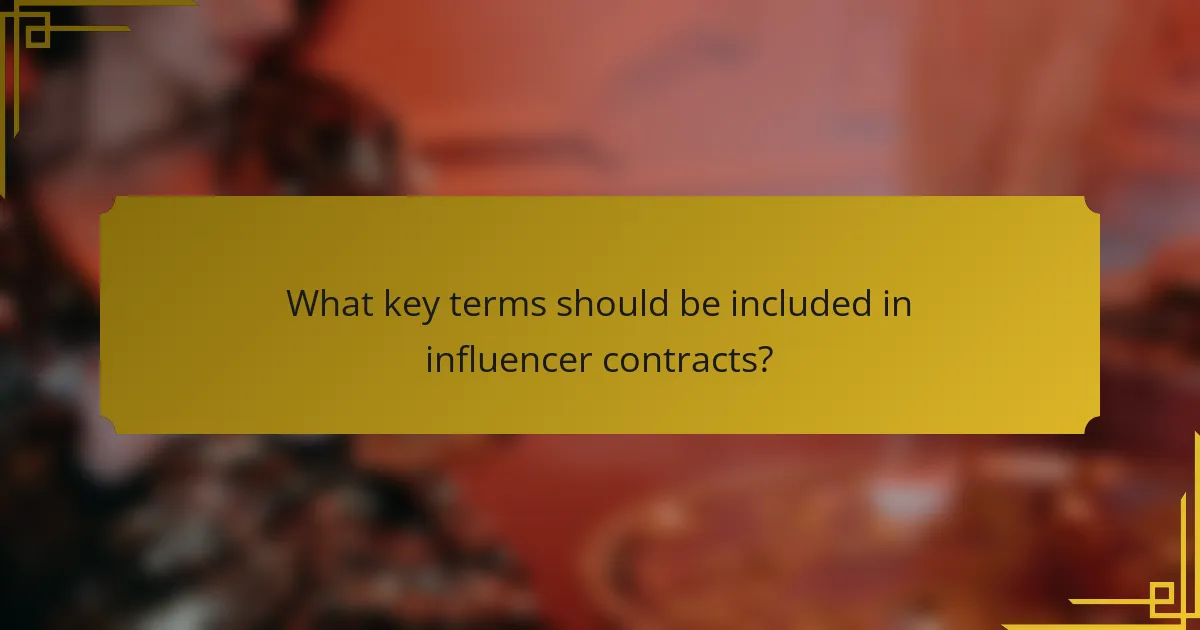Influencer contract negotiation is a critical process that ensures both parties have a clear understanding of expectations and deliverables. By outlining essential terms such as compensation, content ownership, and performance metrics, brands can foster successful collaborations while protecting their interests. Additionally, fair pricing should reflect the influencer’s reach and engagement, aligning with the campaign’s objectives and budget.

How to negotiate influencer contracts effectively?
Negotiating influencer contracts effectively requires clarity on objectives, industry standards, and communication strategies. A well-structured approach can lead to mutually beneficial agreements that align expectations and deliverables.
Define clear objectives
Establishing clear objectives is crucial for successful negotiations. Identify what you want to achieve from the partnership, such as brand awareness, engagement rates, or sales conversions. This clarity helps in framing the contract terms around specific goals.
Consider both qualitative and quantitative objectives. For example, you might aim for a certain number of social media posts or a target reach in terms of audience size. Document these objectives to guide the negotiation process.
Research industry standards
Understanding industry standards is essential for setting realistic expectations and pricing. Research typical rates for influencers in your niche, which can vary widely based on factors like follower count, engagement rates, and content type.
For instance, micro-influencers may charge anywhere from a few hundred to a couple of thousand USD per post, while larger influencers can demand tens of thousands. Familiarize yourself with these benchmarks to negotiate effectively and avoid overpaying.
Establish communication protocols
Effective communication is vital throughout the negotiation process. Set clear protocols for how and when you will communicate, whether through email, video calls, or messaging apps. This ensures that both parties are aligned and can address any issues promptly.
Consider scheduling regular check-ins during the negotiation phase to discuss progress and clarify any misunderstandings. Clear communication helps build trust and fosters a collaborative atmosphere.
Utilize negotiation tools
Leverage negotiation tools to streamline the process and enhance your bargaining power. Tools such as contract templates, pricing calculators, and project management software can help you organize information and present your case effectively.
Additionally, consider using platforms that specialize in influencer marketing, as they often provide insights into pricing trends and facilitate smoother negotiations. These resources can save time and reduce friction in discussions.
Engage legal counsel
Involving legal counsel in influencer contract negotiations is a wise decision. A legal expert can help ensure that the contract complies with applicable laws and regulations, protecting your interests and minimizing risks.
Legal counsel can also assist in drafting clear terms regarding deliverables, payment schedules, and intellectual property rights. This professional guidance helps prevent misunderstandings and potential disputes down the line.

What key terms should be included in influencer contracts?
Influencer contracts should clearly outline essential terms to protect both parties and ensure a successful collaboration. Key terms include compensation structure, content ownership rights, performance metrics, exclusivity clauses, and termination conditions.
Compensation structure
The compensation structure defines how influencers will be paid for their services. This can include flat fees, commission-based payments, or a combination of both. It’s crucial to specify payment timelines, such as upfront payments, milestone payments, or post-campaign settlements.
For example, an influencer might receive a flat fee of $1,000 for a single post, or a commission of 10% on sales generated through their unique affiliate link. Clearly outlining these details helps avoid disputes later on.
Content ownership rights
Content ownership rights determine who retains the rights to the content created during the campaign. Typically, brands seek to own the content for promotional use, while influencers may want to retain rights for their portfolios. It’s essential to specify whether the brand can repurpose the content across different platforms.
For instance, if an influencer creates a video for a brand, the contract should clarify if the brand can use that video on their website, social media, or in advertisements without additional compensation to the influencer.
Performance metrics
Performance metrics are the criteria used to evaluate the success of the influencer’s campaign. These can include engagement rates, reach, impressions, or conversions. Establishing clear metrics helps both parties understand expectations and measure the effectiveness of the collaboration.
For example, a contract might stipulate that the influencer must achieve a minimum engagement rate of 5% on their posts. This ensures accountability and provides a basis for future negotiations.
Exclusivity clauses
Exclusivity clauses prevent influencers from promoting competing brands during or after the campaign. These clauses can vary in duration and scope, so it’s important to define what constitutes a competitor and the length of the exclusivity period.
For example, a brand may require that an influencer not work with any other skincare brands for six months following the campaign. This protects the brand’s investment and helps maintain a consistent message in the market.
Termination conditions
Termination conditions outline the circumstances under which either party can end the contract. This can include breaches of contract, failure to meet performance metrics, or unforeseen events. Clearly defined termination conditions protect both parties and provide a way to exit the agreement if necessary.
For instance, a contract might allow either party to terminate the agreement with a 30-day notice if performance metrics are not met. This ensures that both parties have a clear understanding of their rights and responsibilities throughout the partnership.

How to determine fair pricing for influencer collaborations?
Determining fair pricing for influencer collaborations involves assessing various factors such as the influencer’s reach, engagement, and the specific goals of the campaign. A balanced approach considers both the influencer’s value and the budget available for the collaboration.
Evaluate influencer reach and engagement
Start by analyzing the influencer’s audience size and engagement metrics, such as likes, comments, and shares. Influencers with larger followings typically command higher fees, but engagement rates are crucial; a smaller audience with high interaction can be more valuable than a larger, less engaged one.
Consider using tools like social media analytics platforms to assess these metrics. Aim for influencers whose engagement rates are above industry averages, often around 1-3% for Instagram, to ensure your investment yields results.
Consider campaign objectives
Your pricing strategy should align with the specific objectives of your campaign. If you’re aiming for brand awareness, a broader reach might be necessary, potentially justifying higher costs. Conversely, for targeted conversions, a niche influencer with a smaller but highly engaged audience may be more effective.
Clearly define your goals, whether they are increasing website traffic, boosting sales, or enhancing brand visibility. This clarity will guide your negotiations and help you justify the budget allocated for influencer partnerships.
Analyze competitor pricing
Research what similar brands are paying influencers in your industry. This can provide a benchmark for your negotiations. Look at case studies or reports that detail influencer marketing costs within your niche to get a sense of standard pricing.
Keep in mind that pricing can vary significantly based on the influencer’s platform, audience demographics, and the type of content produced. Use this information to inform your offers and ensure they are competitive yet fair.
Factor in content production costs
When negotiating influencer fees, consider the costs associated with content production. This includes expenses for photography, videography, editing, and any additional creative services required to meet your campaign standards.
For instance, if the influencer needs to hire a professional photographer or videographer, these costs should be factored into the overall budget. Be transparent about what is included in the influencer’s fee to avoid misunderstandings later.
Use pricing calculators
Utilize online pricing calculators specifically designed for influencer marketing. These tools can help estimate fair compensation based on various factors such as follower count, engagement rate, and platform type.
While calculators provide a useful starting point, remember they may not account for unique aspects of your campaign. Use their estimates as a guideline, but be prepared to adjust based on the influencer’s specific value and your campaign needs.

What deliverables should be specified in influencer agreements?
Influencer agreements should clearly outline the deliverables expected from the influencer, including the type of content, posting frequency, and any necessary approvals. Defining these elements helps ensure both parties understand their responsibilities and expectations, which can prevent misunderstandings and disputes.
Content formats and types
Specify the formats and types of content the influencer will create, such as blog posts, videos, or social media posts. For example, an agreement might require three Instagram posts, two TikTok videos, and one blog article. Clearly defining these formats helps align the influencer’s output with your marketing goals.
Consider the platform’s unique characteristics when defining content types. For instance, Instagram may favor visually appealing images, while YouTube requires longer, more engaging videos. Tailoring content to each platform can enhance audience engagement and effectiveness.
Posting schedule
A well-defined posting schedule is crucial for managing expectations. Specify the dates and times for each piece of content to be published. For example, you might agree on a timeline that includes two posts per week over a month.
Flexibility can be beneficial, so consider allowing the influencer to suggest optimal posting times based on their audience insights. However, ensure that any changes to the schedule are communicated and agreed upon to maintain consistency in your campaign.
Approval processes
Establish a clear approval process for content before it goes live. This may include reviewing drafts or final versions to ensure they align with your brand guidelines and messaging. For instance, you might require that all posts be submitted for review at least three days prior to the scheduled posting date.
Define the timeline for feedback and revisions to avoid delays. A common approach is to allow for one round of revisions, ensuring that the influencer has the opportunity to make adjustments while keeping the project on track. Clear communication during this process is key to maintaining a positive working relationship.
